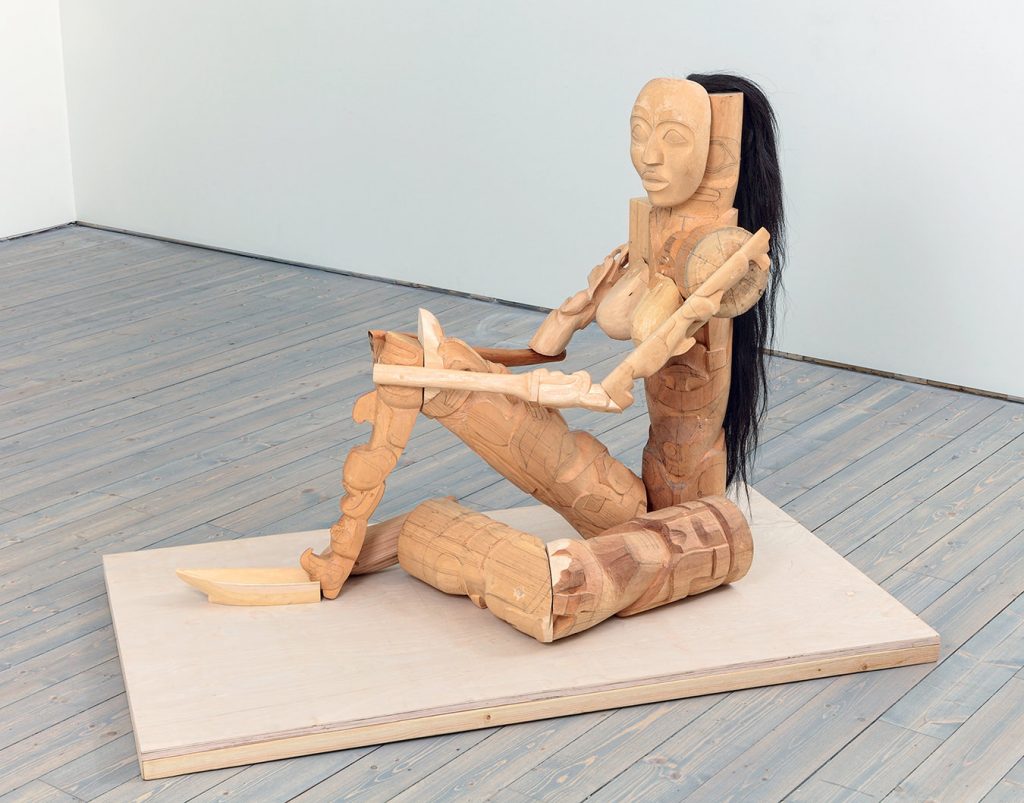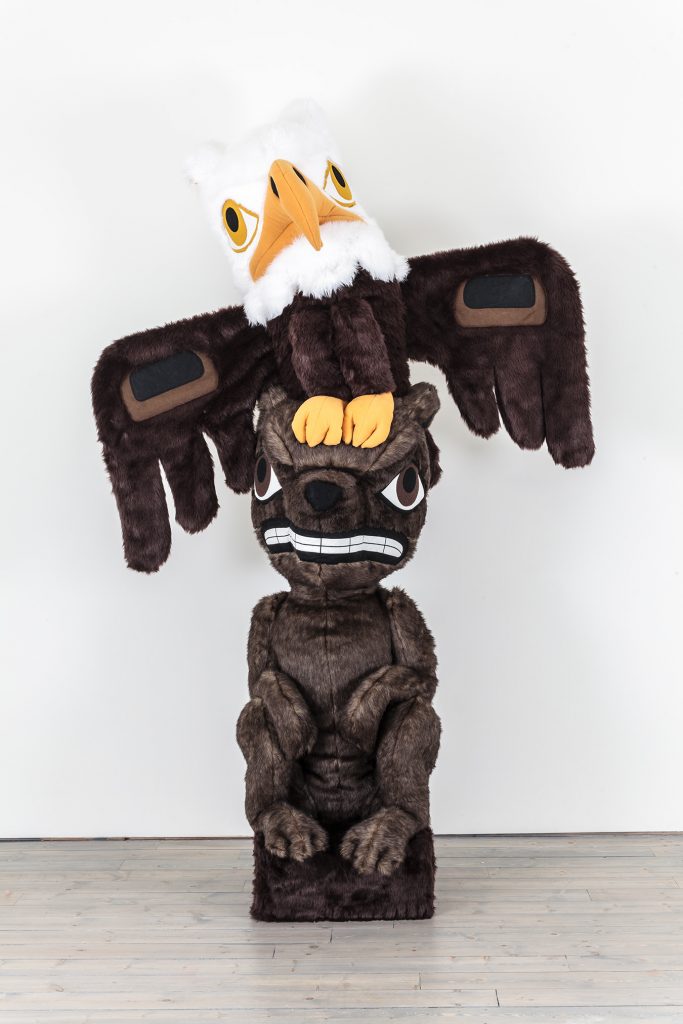The lighting in this long and cavernous atelier is quite dim—the only light stems from a large lamp shining on the paintings of First Nations artist Shawn Hunt—emotive, beguiling fusions of dimension and colour.
“What I’m trying to do is continue the long line of creating art that my people have done over the years,” explains Hunt. Since graduating from the University of British Columbia’s Fine Arts program in 2000, Hunt has had an impressive career spanning jewellery making, sculpture, and most recently, painting. “I’m creating art using traditional elements and motifs, and even traditional methods of making things, but I’m living now, and dealing with modern issues.”
Case in point: an exquisite panel, When The Lights Go On (2009). Measuring six-by-eight feet and carved in red cedar, the work formally draws inspiration from Théodore Gericault’s 1819 painting The Raft of the Medusa, and depicts the seminal moment in First Nations lore when Raven raises the sun, introducing light into the world. For Hunt, however, the piece holds a more political reading, cogently calling attention to the racial prejudice and inequity that has long plagued Canada’s First Nations people since colonization. “I was playing off that idea of coming out of the darkness, coming out and being afraid of some culture that we’re not familiar with and realizing that we’re all in the same boat here. We’re all human beings.”
Fear, and conquering fear, is a big motivator for Hunt, which explains his recent decision to uproot himself from the Sunshine Coast and relocate his practice to Vancouver. This same precariousness guides his art-making as well. For one who constantly disturbs his own peace, there is definitely an air of certainty, even serenity, about Hunt. He’s taken chances before, and knows what’s at stake. “For me, it’s about learning something, getting better at it, and then getting to a point where I can push the conversation forward,” he says. Thus, each of his pieces is an instalment in this cultural progression, a new idea in an ongoing discourse.
Currently, this newest thing is Hunt’s painting. He strides towards the far wall where his canvases are displayed. From a distance, the paintings are evidently portraits. But upon closer inspection, each visage is an elaborate composition of elements drawn from northwest coast First Nations art, integrated and interlocked in a strange, haphazard harmony. “Every one of my portraits comes directly from my mind,” says Hunt. “There’s no looking at a photo—just pure imagination.” He is animated as he describes the centremost painting, moving his hand over the canvas with the deftness of a sculptor; his interdisciplinary practices converge on these works remarkably.
The gaping mouth is an ovoid element, pinched to form the figure’s lips; a silvery blue salmon head constitutes the left side of his face. What appears to be a pronounced cheekbone is in fact the bright red beak of an eagle, protruding through the salmon’s eye; and a split U-shape grants the figure his great, green nose. Atop these muddled motifs is an eye, stretched in emphatic two-dimensionality along the colliding contours; it evokes the signature clocks in Dalí’s surrealist works.
“The Modernists looked at First Nations’ work and were inspired by it to take their portraits, or their representations of human beings, and delve deeper inside to get at the psyche of the person. That’s what I’m trying to do as well.”
Surrealism drew inspiration from the First Nations of the northwest coast, and Hunt’s work continues to converse with these Modernist movements. Nevertheless, this negotiation between native art and Modernism operates within a decidedly Eurocentric anthropology; it is native culture misrepresented, divorced from its everyday purposes and forced into a state of radical otherness. “I’ve often looked at the way the dominant culture here has displayed our work and given meaning to it,” Hunt says. There is no anger or resignation in his tone, but rather a curiosity—an anthropologist studying anthropologists. “A mask, most of the time, is photographed with a completely black background, as sort of this face floating with no body—no connection to the culture whatsoever. The mask as just the mask.”
Where Western anthropology seeks to isolate and contain meaning, Hunt’s artworks are a response to this hegemonic tendency and embrace the uncertainty, randomness, and ineffable complexity of human beings. Here, Hunt happily takes a cue from the surrealists: “The Modernists looked at First Nations’ work and were inspired by it to take their portraits, or their representations of human beings, and delve deeper inside to get at the psyche of the person. That’s what I’m trying to do as well.”
It’s a far cry from Hunt’s earlier paintings, which he describes deprecatingly as merely “designs executed in colour”. Apart from painting sculptures, Hunt had never worked with the medium. “I wasn’t using paint to create the illusion; it was very flat and on the surface.” His latest works are inspired by Ovoidism, a style of contemporary native art which acclaimed B.C. artist Lawrence Paul Yuxweluptun developed as an Aboriginal answer to cubism. And it makes sense, given that Yuxweluptun has been helping Hunt to hone his technique over the past two years. Yuxweluptun shares this same studio, and his canvases can be glimpsed in the shadows at the far end of the room.
The story behind Hunt and Yuxweluptun’s working side by side is a serendipitous one. As Yuxweluptun was walking down South Granville, Hunt’s Dancing Frog (2009), displayed at Douglas Reynolds Gallery, caught his eye from across the street. Yuxweluptun knew Hunt as a sculptor, but the painting took him by surprise. Hunt laughs as he remembers Yuweluptun telling him, “You can design. Obviously. But you can’t paint”. Even so, Yuxweluptun saw promise in the younger artist.
“My working relationship with Lawrence Paul has been pretty incredible.” There is unmistakable gratitude in Hunt’s smile as he speaks. Hunt sees his work as lacking the overt social and historical commentary inherent in Yuxweluptun’s art; nonetheless, his mentor’s influence manifests from time to time. Hunt is in the process of completing his first landscape: a turbid dissonance of impossibly networked roads and cold, cobalt-coloured buildings juxtaposed against a fiery dusk. Hunt intends to add various little details to accentuate the austere city; but most importantly, he will add two people—one reading a GPS, the other poised with a spear. “They’ll be looking for the river that once flowed through here,” he says sombrely, evoking a cutting environmentalist critique that would make Yuxweluptun proud.
Although Hunt has been concentrating on painting recently, his exhibition, “Artifake”, showing at Macaulay Fine Art this summer, from May 22 until July 17, focuses primarily on sculpture and offers only a glimpse into his work on canvas.
“For the time being, I’m always going to be judged against this guy,” chuckles Hunt, nodding toward Yuxweluptun’s ominous welcome figure. “But, there’re worse things than to be judged against Lawrence Paul. So I’m okay with it.” Although his career already spans over a decade of outstanding craftsmanship, Hunt abounds with an energetic and youthful anxiousness. “He’s made his place, and so I just have to make mine now. Do my thing to make my statements. It’s challenging, but as you know, I enjoy the challenge.”
Photos: Barb Choit. All images courtesy of Macaulay Fine Art.












